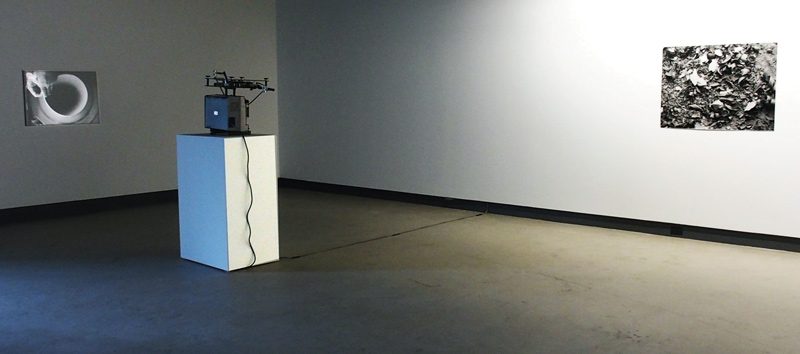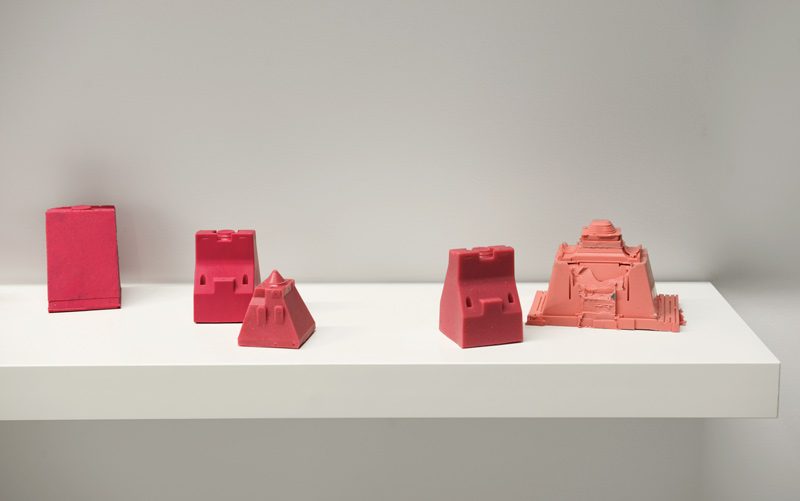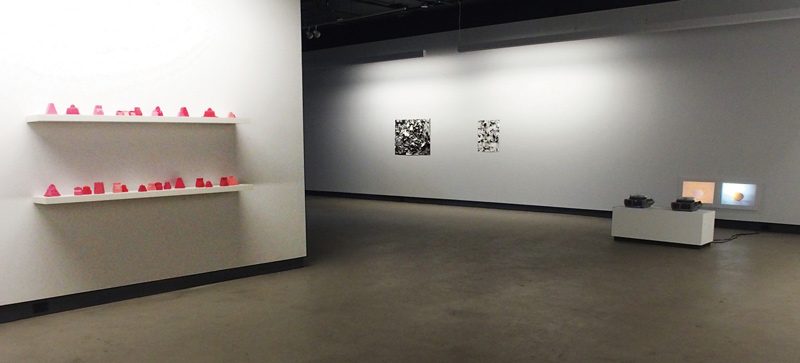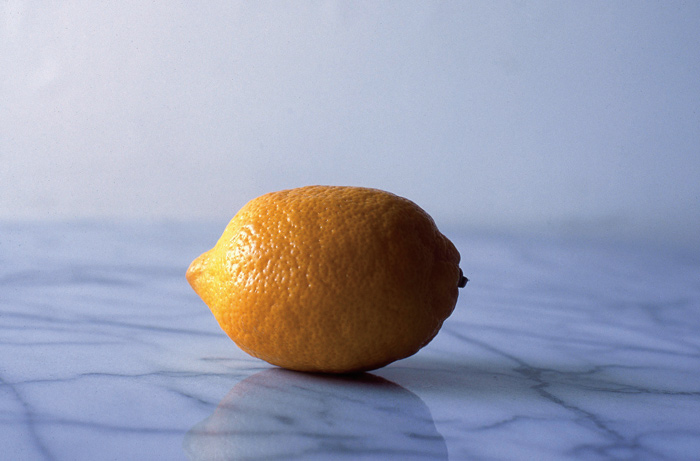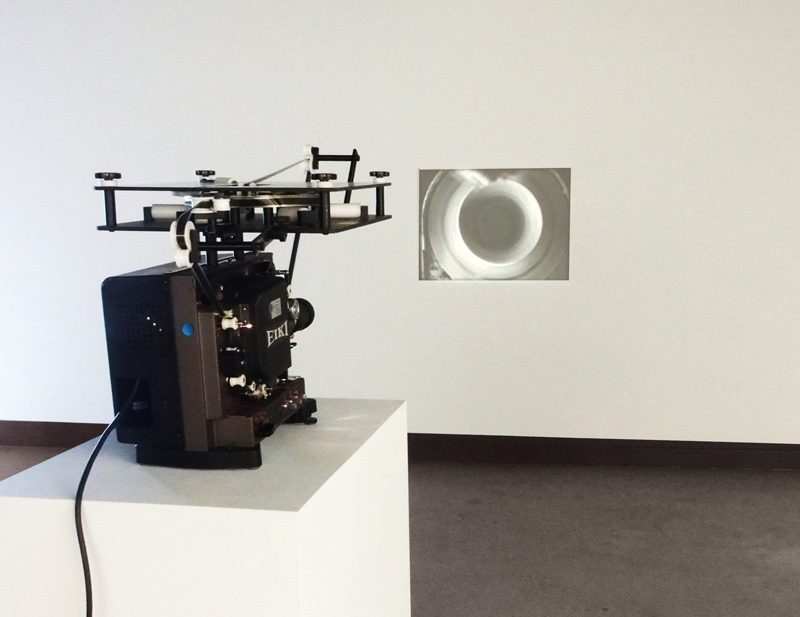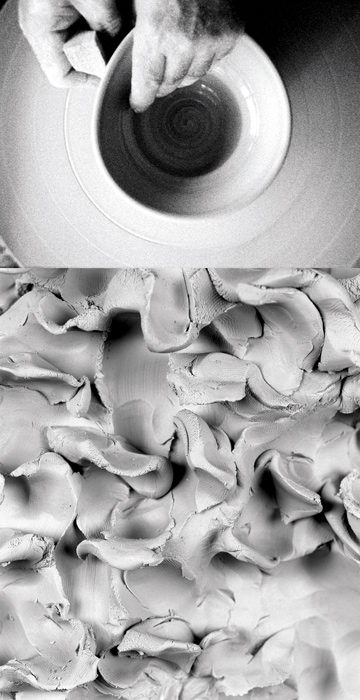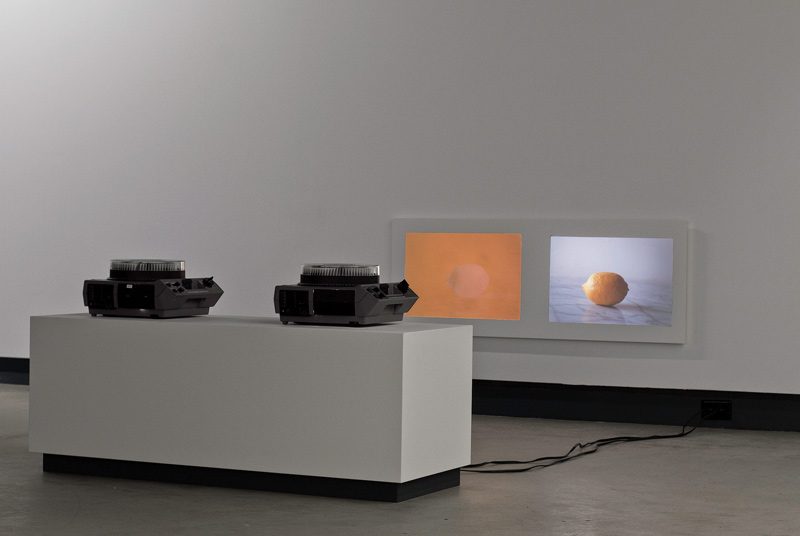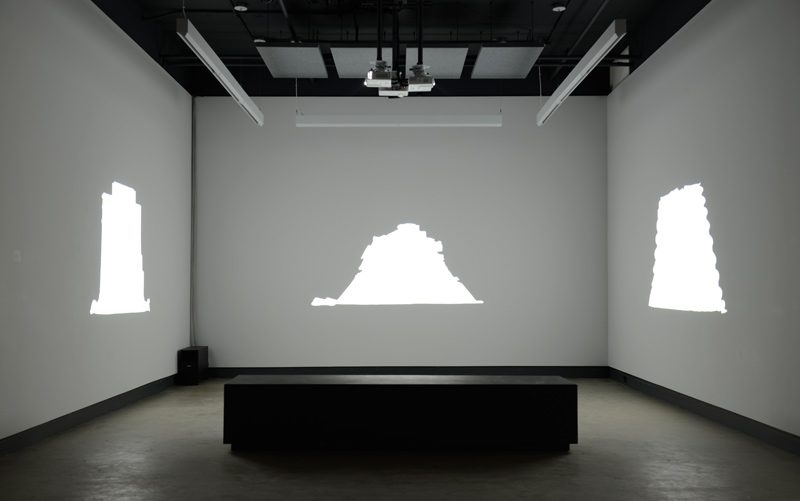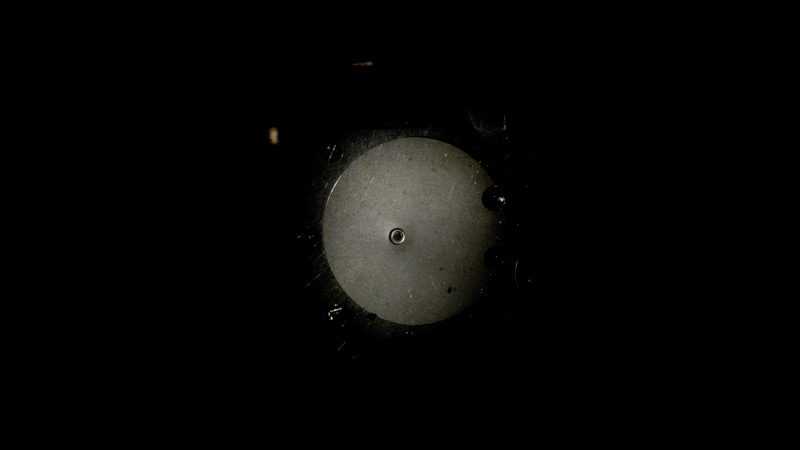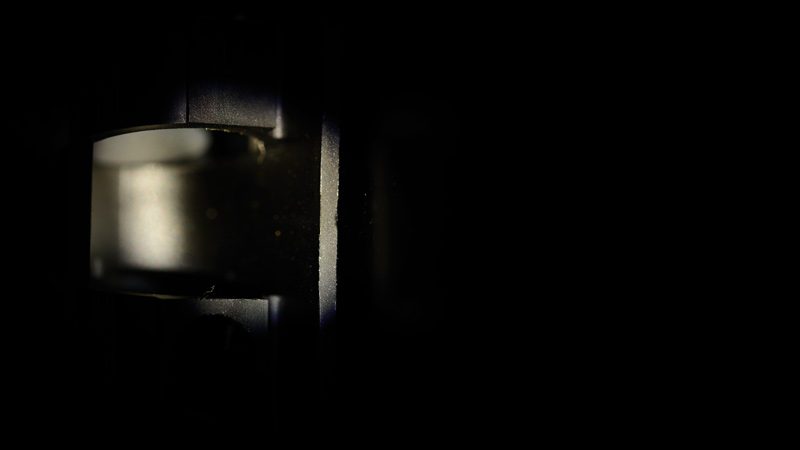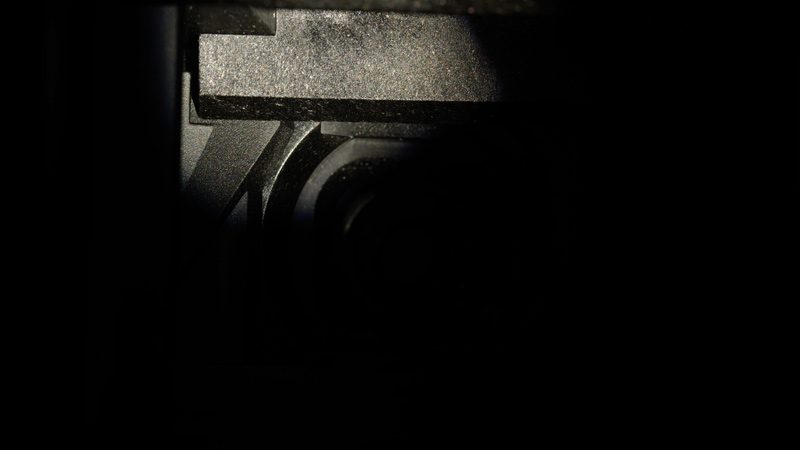Lorna Bauer | Jon Knowles
Film/Unfilm, Rotations
Jacinthe Lessard-L.
La chambre inversée, Les chambres étalées
Par Charles Guilbert
It is quite uncommon for the association of two exhibitions to create a dialogue that becomes an artwork in itself. Yet, this is what Dazibao did by bringing together works by Jacinthe Lessard-L. and by the duo formed of Lorna Bauer and Jon Knowles.1 Their respective works, although different in tonality and look, intertwine to lead viewers into a surprising reflection on darkness, notably by establishing connections between photography and sculpture. The fact that each of the works exhibited explores, on its own, the issues of doubling, exchange, and reversibility no doubt contributes to the coherence of the dialogue.
One of the exhibitions is based on the encounter of two artists. Lorna Bauer and Jon Knowles, each of whom has an independent practice (hers in photography and his in installation), have created seven works together. The sharing of their intuitions gives rise to a world in which two apparently contrary attitudes are reconciled: a conceptual distancing of the image and an immersion in the poetic power of the image.
The two strongest works presented by Bauer and Knowles, Film/Unfilm and Rotations, take up – though with certain discrepancies – strategies, manners, and a mechanism that evokes those used by conceptual artists. They thus establish an ironic backdrop that invites viewers to bring degrees into play as their gaze oscillates between the cold indifference induced by the distanced commentary and the heat that emanates from the images.
To the right, we see a lemon sitting on a marble table; to the left, a very similar image, but in negative (a bluish shape floating on a yellow background). Each of the two slide carrousels contains eighty images that display alternately. The dialogue between the two series of images, however, somehow muffles the clicking chant of the carrousels rotating in the projector. The barely perceptible differences among the successive images and the simplicity of the two compositions encourage viewers to become immersed in a meditative experience that is tinged with the absurd. After a few minutes, the stratagem is revealed: the lemon was photographed at regular intervals as night fell until it became invisible. Thus, the positive image becomes darker and the negative image becomes lighter.
Rather than being disappointing, the predictability of the unfolding series allows viewers to abandon themselves to viewing. The deconstructed double animation engages us in paying total attention to the transformation of light (the same light that sets the pace of our own lives). And what is surprising – an absolutely muted surprise – is the passage from light to darkness (on the right side) and from darkness to blinding white (on the left side).
There is a time lapse between one eclipse and the other, as the faltering low-tech mechanisms of the ageing projectors result in breaks in rhythm and desynchronization. Thus, the mechanism highlights a certain frailty of the image (on the path to extinction) but also the cyclical aspect of the work, reflected in the round shape of the slide tray, the lemon, and the marble table on which the lemon is placed. This roundness evokes, of course, the shape of the planet, which is source of these changes of light.
And we cannot keep ourselves from hearing, in the back- ground, Bauer and Knowles making fun of the obsolescence of the projector and laughing at how attracted conceptual artists were to setting up programs based on evidences – our vision, at the start, becoming above all thought, distance, critique. But quickly we are immersed in an act of vision, very physical, that recalls the one described by Merleau-Ponty in “Eye and Mind”: “The eye accomplishes the prodigious work of opening the soul to what is not soul – the joyous realm of things and their god, the sun.”2
Through the double eclipse of Film/Unfilm, I sense this world in which the lemon and I are immersed. The distance that separated me from the lemon gradually fades away. Not being able to do better than Merleau-Ponty in trying to name this “mystery of passivity”3 of vision, which seems to me to be the very intention of Bauer and Knowles, I will quote him again, and at length: “Visible and mobile, my body is a thing among things, it is one of them. It is caught in the fabric of the world, and its cohesion is that of a thing. But because it moves itself and sees, it holds things in a circle around itself. Things are an annex or prolongation of itself; they are incrusted in its flesh; they are part of its full definition; the world is made of the very stuff of the body. These reversals, these antinomies, are different ways of saying that vision is caught or comes to be in things – in that place where something visible undertakes to see, becomes visible to itself and in the sight of all things, in that place where there persists, like the original solution still present within crystal, the undividedness of the sensing and the sensed.” 4
Merleau-Ponty terms as “reversibility” the strange interlacing in which the relationship between seeable and see-er is created. Through its very title, Film/Unfilm suggests a certain reversibility – with some humour of course, as filming in negative is not “unfilming” (unless the “unfilm” of the title is the ultimate obscurity, black or white, at the end of the image sequences). The antithetical friction of the two series of lemons seems to aim for a sort of cancellation of the image. Yet, the addition of the positive and the negative does not lead there. Instead, it gives rise to a third, very powerful image: that of an engulfing.
Jacinthe Lessard-L.’s video installation, La chambre inversée, extends these questions. The dark room that she has made for us to enter is (as we will discover) the dark chamber within the camera – the place that, normally, secretly receives light to give birth to an image and is never discovered. Meticulously and slowly, the artist photographed the path of a beam of light through the dark chamber of a number of cameras. An image-by-image animation of this exploration is presented through three projectors (on the left-hand, centre, and right-hand walls) in a room that is muffled and shut off by black curtains. Because the light beam used by the artist is very narrow, the context for the fragmentary images that we see evades us at first. The clues that we glean as we watch (the metallic texture of the chamber lining, for example, or a glimpse of mechanical parts) make us think, in turn, of a safe, a drilling rig, a tank . . . until the illumination.
In turning her gaze toward the inside of the camera rather than toward the exterior (to which the camera usually points), the artist suggests a reflection on the origin of the images that are made possible by analogue photography. She exposes the darkness and the void that were, for many years, necessary to make any image appear. But she goes even further: she transforms the projection space itself into a dark chamber in which she places the viewer, thus abolishing the distance that normally separates the viewer from the image. She plunges the viewer into the very space where the image is produced. The viewer is engulfed in that space – in a way that somehow resonates with the experience of obliteration offered by Film/Unfilm. Informed by his experience as a viewer of pictorial works, Merleau-Ponty deduces in Eye and Mind that all of our relationships with space are similarly immersive: “Space is not . . . a network of relations between objects such as would be seen by a third party, witnessing my vision, or by a geometer looking over it and reconstruct- ing it from outside. It is, rather, a space counted starting from me as the null point or degree zero of spatiality. I do not see it according to its exterior envelope; I live it from the inside; I am immersed in it. After all, the world is around me, not in front of me.”5
Lessard-L. exaggerates the profoundly physical aspect of vision by appending sound to her images. To establish this dialogue, she enlisted composer Julien Bilodeau, who has created a suite of sound interventions from recordings of mechanical noises made by various cameras. The musical fragments precisely follow the appearances and disappearances of the light beam, matching not only their rhythm but also their position in the space (thanks to a 5.1 surround sound system with six speakers). The sound constantly reminds viewers that vision is a thing of the body, of position in space, of orientation, of immersion.
Despite this rhythmic and spatial concordance, a discrepancy is created, as the music evokes a sense of suspense that is countered by the cold, rather repetitive images. Given this grating fiction, the viewer is buffeted between connotation and denotation, unease and aloofness, account and examination. The drama that simmers here seems both grandiose and banal.
After an exploratory period, bluish spinning pyramidal shapes appear on the centre screen. The spectator can guess that these are spaces marked out from the beginning, but seen from the outside. Thus, for a few seconds the viewer has access, from a distance, to the volume that had been swallowed in darkness. Then, in a sort of sudden apotheosis emphasized by the music, three large pyramidal shapes, all of them white and unmoving, invade the walls. These luminous flat areas, we deduce, are overexposed photographs of three sides of the castings of dark chambers.
Thus, the camera’s dark chamber is triply inverted: rather than filming, it is filmed; the emptiness that composes it becomes a fullness; and rather than being a dark space, it becomes a flat plane of raw light. There is something playful in Lessard-L.’s way of producing images by bringing the tool for taking pictures together in different ways. But underlying the playfulness is a careful reflection on photography and reality.
By highlighting the successive transformations involved in creating images, the artist reveals the unstable, undefined, plastic, and moving nature of what we call reality. With her multiples inversions, she ventures into a certain negativity that is reminiscent of Plotinus’s disconcerting ideas on mat- ter, which Joseph Cochez summarizes thus: “A corporal sub- stance is composed of a form existing in matter. These two elements are independent of each other: matter remains absolutely indifferent to form and is a non-being; it receives the form, as a mirror (that in reality would not exist) would receive an image. It is precisely for this reason that bodies are not true reality, even though we often like to take them for true beings.”6 Like Plotinus, Lessard-L. seems to me to be probing the subterranean dimensions of reality in order to deduce its mysterious dynamic.
Matter – understood in its common, rather than Plotinian, sense – is an object of fascination for the artists in both exhibitions. In fact, this is what brings them to link photography and sculpture.
Rotations, by Bauer and Knowles, is a 16 mm black-and-white silent film. Taking inspiration from the look of 1960s documentary films on trades, and adhering strictly to elements of formalist grammar (sharp cuts, unexpected angles, rapid zoom-outs, jumps in the image), the artists present the creation of a bowl by a potter. As in Film/Unfilm, circularity is present: the mechanics of the potter’s wheel are placed in relation with the projector, whose looped bobbin is placed horizontally.
The camera, in overhead angle, captures only the bowl at first; then, it zooms out to show the potter’s hands as they shape the clay to create an ideal form. The potter stops the wheel, uses a wire to detach the bowl from the round platform, and starts the wheel again to perform a quick cleaning (the three-minute loop then begins over). Once again, distance and coldness are imposed: no context is given (the potter’s face remains out of frame) and the action filmed leads to a very predictable conclusion. But, once again, the banality of the subject, the simplicity of the story, the choice of inexpressiveness, and the formal clarity encourage a contemplation interrupted by several epiphanies.
By overlapping craft and cinema, Bauer and Knowles evoke the possibility of a gesture of simultaneous creation (in three minutes, a bowl and a film are made) – and isn’t this the fusion that, as a duo of artists, they are trying to effect? By choosing to show only a part of the potter’s body, they point to the out-of-frame (where the camera operator, Isabelle, is found; she presented a complementary exhibition, in the tight space of La Mirage,7 several floors above). Once again, guided by their interest in darkness, the artists highlight the question of the void and depth for, as the bowl is hollowed out, a central black zone is formed. This space, as reconstituted by the film image, becomes mysterious, especially when the potter’s hands plunge into it. Surprisingly, the flattening caused by the transition from real object to image creates an unfathomable depth. This is the primary dimension about which Merleau-Ponty talks: depth, the search for a “deflagration of Being”: “Four centuries after the ‘solutions’ of the Renaissance and three centuries after Descartes, depth is still new, and it insists on being sought, not ‘once in a lifetime’ but all through life.”8
The work by Lessard-L. on view as we enter the exhibition space also addresses the question of depth by linking image and sculpture. On each of two white shelves, arranged vertically, are fifteen small pink objects. In an exhibition space devoted to the image, the strictly sculptural aspect of the work is surprising. These objects evoke children’s toys: houses, castles, pyramids, toy pails. We understand that these are castings, as we find several copies of the eight shapes in five different shades of pink. The systematic aspect of the process and the work’s title, Les chambres étalées (The Stacked Chambers), indicate a conceptual game linked to photography: these forms are castings of eight camera dark chambers (the same ones that we will later find in the video installation).
Adopting an attitude specific to the workings of photography (the analogic transfer of information, the search for imprints, the revelation), Lessard-L. updates these matrices of the image, which, because of their carnal colour, we cannot help but associate with the human matrix that is the uterus. These full, colourful shapes originate in something that is at once void, darkness, and past. Their stacked placement reminds us, with a smile, of our viviparous condition and perhaps even of the void before existence. “Sometimes, men forget that they are not before being,” writes Pascal Quignard in Les Ombres errantes.9 He adds, “Between images and the void, there is a precipice. There is only one passage-way across. . . . It is so perilous that few risk it, and no one can say if anyone has ever gotten across.”10 This work by Lessard-L. reminds me of this type of crossing.
Many other aspects contribute to the rich dialogue between these two exhibitions, including interest in savoir-faire and in the past (as manifested, notably, in the renewed commitment to artistic currents that have been declared outdated and in technologies that are being abandoned). One could see this as nostalgia and conservatism. However, these artists’ approach has nothing at all to do with resistance to change. “Being there, where the origin is lost,”11 out of frame and beyond time: that is what they are seeking. By infiltrating the past in a combination of darkness and light, of distance and immersion, they succeed in their quest.
Translated by Käthe Roth
2 Maurice Merleau-Ponty, “Eye and Mind,” in The Merleau-Ponty Aesthetics Reader: Philosophy and Painting, edited by Galen A. Johnson; Michael B. Smith, translation editor (Evanston, IL: Northwestern University Press, 1993), p. 146.
3 Ibid., p. 136.
4 Ibid., pp. 124–25.
5 Ibid., p. 138.
6 Joseph Cochez, “L’esthétique de Plotin,” Revue néo-scolastique de philosophie, vol. 20, no. 80 (1913): 432 (our translation).
7 La Mirage is situated at 5445 avenue de Gaspé, 6th floor, space E6-03.
8 Merleau-Ponty, “Eye and Mind,” p. 140.
9 Pascal Quignard, Les ombres errantes (Paris: Grasset, 2002), p. 14 (our translation).
10 Ibid., p. 73 (our translation).
11 Ibid., p. 18 (our translation).
Lorna Bauer lives and works in Montreal. She has presented her work in solo exhibitions at Galerie Nicolas Robert; YYZ Artists’ Outlet; Gallery Les Territoires; the University of Toronto Art Centre; and the Art Gallery of Mississauga.
Jon Knowles lives and works in Montreal. He studied at Nova Scotia College of Art and Design, Cooper Union (New York), and Concordia University. His recent solo exhibitions include Works with Photography at Vox, Centre de l’image contemporaine, I’m only in it for the Manet at G Gallery, Blood Oranges at Galerie Laroche/Joncas, and Mixed Misuse at the Darling Foundry.
Jacinthe Lessard-L. holds a master’s degree in visual arts from Concordia University. She lives and works in Montreal. Her work explores themes such as the nature of photography, its historical role, its transparency, and its relation to the referent. She collaborates regularly with other artists, including Eduardo Ralickas and Erika Kierulf, and with Yusuke Nishimura, Frederick Vidal, and Sylvia Doebelt for the many-sided exhibition Blue Skies and Cats (B-312 gallery, 2014).
Charles Guilbert is an artist, writer, and critic (charlesguilbert.ca). His artworks have been presented in Quebec and abroad, including at the Musée d’art contemporain de Montréal, the Manif d’art in Quebec City, the Casino Luxembourg, and the Metropolitain Museum in Tokyo.

